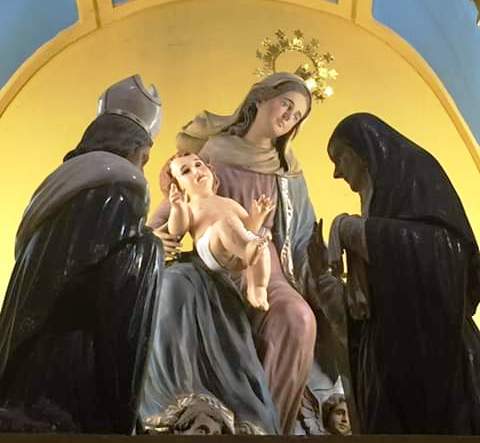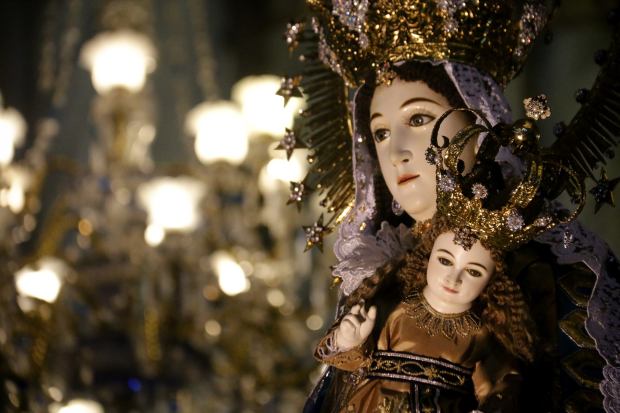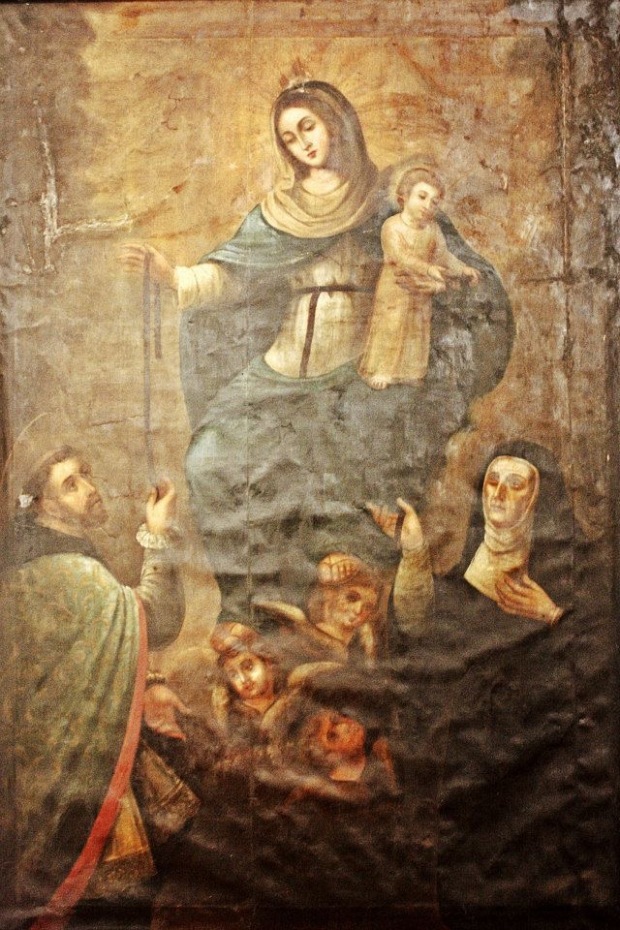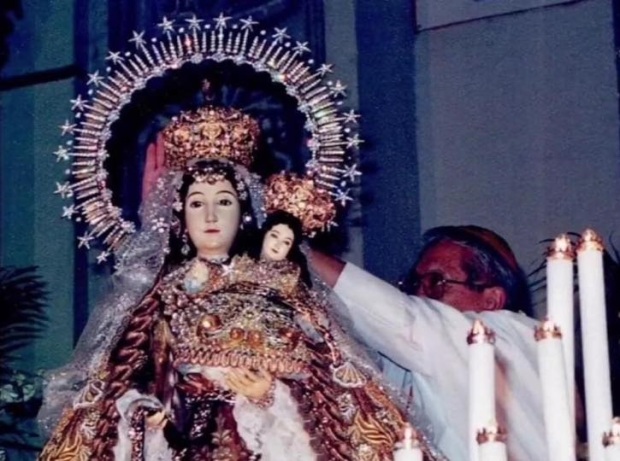
Written by Rev. Fr. Ericson M. Josue
Editor’s note: While I am doing some research on the devotion and history of Nuestra Señora de la Consolacion y Correa of San Agustin Church of Intramuros, Manila for a blogpost dedicated to her, I stumbled upon this post and research regarding the devotion to Nuestra Señora de la Consolacion y Correa in Ilocandia and its current state by Fr. Ericson Josue which shows the sad state of the devotion to La Consolacion given that the Ilocandia region was in fact an Augustinian mission province and it is inevitable that the devotion to Our Lady of Consolation and Cincture will be propagated. The devotion to La Consolacion in Ilocandia was similar to the case in Bulacan province (the Augustinian Mission side) that it almost went into oblivion if not through the efforts of the members of the Cofradia de la Nuestra Señora de la Consolacion y Correa.
What I’ll be presenting in this blogpost is the full article on this topic written by Fr. Josue to let the readers have a grasp on the condition of this ancient devotion to the Blessed Virgin Mary of the Augustinian family and have this one shared and hopefully revitalized the devotion in Ilocandia.
Annually, during the Month of September, some parishes in the Ilocos celebrate a feast of Our Lady in her title as Our Lady of Consolation. In my hometown of Pasuquin, I remember as a young boy of a petite image of Mary called by devotees as “Apo Consolación” being venerated on the first week of September, following the feast of St. Augustine at the end of August. I remember a group of old men calling themselves as “Diputados de la Correa.”

Decades after, only few parishes still commemorate the Blessed Mother in this title, like in the old parishes of San Guillermo in Laoag, Santiago Apóstol in my hometown of Pasuquin and San Andrés in Bacarra.
In an old Book of Inventory (1898) of Ilocos Norte Churches being kept at the National Archives of the Philippines, it appeared that all parishes of Ilocos Norte had images of “Nuestra Señora de la Consolación de la Correa” (Our Lady of Consolation of the Leather Belt) with adornments of jewelries and regal clothings. This attests that there was a strong devotion of our ancestors to “Apo Consolación.” In the parish archives of Narvacan and Bantay in Ilocos Sur and Batac in Ilocos Norte, there are books marked as “Libro de la Cofradía [de la Correa]” (Book of the Confraternity of the Leather Belt). Here, the names of members of a confraternity related with the “Belt” were enlisted with their “Hermano Mayor” (Senior Brother) who served as the group’s Senior Member for a year. In the mid-1800’s, Bishop Juan José Aragonés, OSA reported to the Spanish King of the presence of the confraternity in all Ilocano towns.
Let us have an initial attempt in tracing how “Apo Consolación” became known to the Ilocanos?
First, we should know that “Apo Consolación” is the Mary of the Augustinians who brought Christianity to the Ilocandia. A story has it that when Augustine was immersed in his mundane lifestyle, his devout mother Monica saw an apparition of Our Lady handing over to her the leather belt (Spanish: correa). Tradition says that Mary’s appearance to Monica gave the latter consolation from her afflictions caused by her delinquent son. We know that it ended with Augustine’s conversion to the Faith.
Later, a devotion was developed among devotees by wearing a leather belt to gain Mary’s protection and consolation. This was primarily propagated by the friars from the Order of St. Augustine, the religious order following the ancient “Regla” (Rule) of St. Augustine who also wore the leather belt as part of their religious garb. Among their means of propagation was the establishment of the “Cofradía de la Nuestra Señora de la Consolación de la Correa” (Confraternity of Our Lady of Consolation of the Leather Belt) in all parishes of the Ilocandia, whose members were called “Diputados de la Correa” (Deputies of the Belt). The “Diputados” were deputized to wear the (Augustinian) leather belt. They celebrated “Apo Consolación’s” feast on the Sunday within the octave of St. Augustine’s feast (August 28).

Today, in Ilocos Norte, after more than a century since the eviction of the Spanish Augustinian “Frailes,” only the aforementioned parishes of Laoag, Pasuquin and Bacarra keep to their piety the devotion to “Apo Consolaciòn.” No traces were found yet when and how the devotion diminished. This could only be done in a serious and thorough research.
“Apo Consolación” was among the important images of Mary. It was as important as the Our Lady of the Rosary to the Dominicans or “Nuestra Señora del Cármen” to the Carmelites. For devotional paraphernalia, the Augustinians have the “Correa,” the Dominicans have the “Rosary” and the Carmelites have the “brown scapular.”
It must be known that Ilocano Catholicism could not be understood fully without reference to its Augustinian origins. Our Catholic Faith came to us through the Augustinian Tradition. One good study is to retrieve or rediscover the Augustinian elements embedded or now hidden in our Ilocano practices of the Faith. This will help us more understand our identity as Ilocano Catholic. Pope Francis has these words to add: popular piety as “a fruit of the inculturated Gospel, is an active evangelizing power which we must not underestimate…[they] have much to teach us; for those who are capable of reading them, they are a ‘locus theologicus’ which demands our attention, especially at a time when we are looking to the new evangelization.”(Evangelii Gaudium, 125-126).
With this, let us retrace “Apo Consolación” in the elements of our Ilocano piety. The forgotten Mary of the Ilocanos is just there journeying with us unnoticeably.
Consolatrix afflictorum, Ora pro nobis!
Reference:
Josue, Ericson, “The Forgotten Mary of the Ilocanos”, St. Michael the Archangel Parish, Currimao,Ilocos Norte, 2015.
Special Thanks to Mr. John Erish Albano and Dr. Fritz Bernardo, MD for the photogrpahs of Our Lady of Consolation and Cincture of Bacarra and Paoay, Ilocos Norte.
A special thank you to Rev. Fr. Ericson Josue for sharing us this striking research on the devotion to Nuestra Señora de la Consolacion y Correa in Ilocandia.
+AM+DG+








